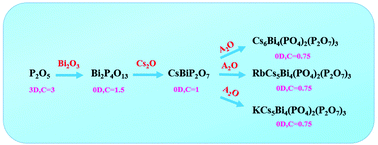ACs5Bi4(PO4)2(P2O7)3 (A = K, Rb and Cs) with two kinds of isolated P–O groups designed by dimensional reduction theory†
Abstract
The dimensional reduction theory is applied to an A2O–P2O5–Bi2O3 system where P2O5 serves as a binary parent while A2O and Bi2O3 are regarded as dimensional reduction agents. Thus, three novel phosphates ACs5Bi4(PO4)2(P2O7)3 (A = K, Rb and Cs) have been prepared through the high-temperature solution method. Single-crystal X-ray diffraction measurements reveal that they all crystallize in the monoclinic space group P21/c (no. 14) and in their structures, two different kinds of P–O units, i.e. isolated PO4 tetrahedra and P2O7 dimers, are interconnected by Bi–O groups to construct a 3∞[Bi4(PO4)2(P2O7)36−] framework. Note that with the change of cationic size in their structures, the Bi3+ cations also exhibit flexible coordination, i.e. BiO5 and BiO6 polyhedra in KCs5Bi4(PO4)2(P2O7)3 and only BiO6 polyhedra in Cs6Bi4(PO4)2(P2O7)3, suggesting that combining the flexible coordination of Bi3+ cations with phosphates based on dimensional reduction theory is an effective strategy to guide the synthesis of new compounds.



 Please wait while we load your content...
Please wait while we load your content...